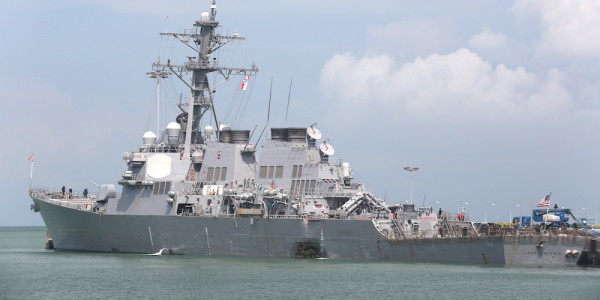

The Navy has launched what a defense official characterized as a “broad investigation” into the Japan-based 7th Fleet’s performance following the collisions of two Arleigh-Burke class guided missile destroyers with commercial vessels the last two months, the Associated Press reports.
Chief of Naval Operations Adm. John Richardson ordered a pause in global operations in the wake of the collision, according to USA Today, reportedly directing U.S. Fleet Forces Command chief Adm. Phil Davidson to lead an investigation to “ensure there aren’t bigger problems that may be masked by the high pace of ship operations in the Pacific region,” the anonymous defense official told the Associated Press.
News of the investigation came less than 24 hours after the USS John S. McCain collided with the merchant vessel Alnic MC, a Liberian-flagged oil and chemical tanker, in the waters east of the Strait of Malacca while both vessels were en route to Singapore on the morning of Aug. 21.
Ten sailors were reported missing and five injured amid significant flooding to the destroyer’s crew berthings and communications equipment. The Navy immediately launched search and rescue efforts in conjunction with Singaporean naval and coast guard vessels shortly after the collision occurred at 6:24 a.m. local time.

Damage to the port side is visible as the guided-missile destroyer USS John S. McCain (DDG-56) steers towards Changi Naval Base, Republic of Singapore on Aug. 21, 2017.Photo via DoD
The McCain collision occurred two months after the USS Fitzgerald collided with the Philippine-flagged merchant vessel ACX Crystal on June 17, resulting in massive damage to the destroyer’s starboard side below the waterline. Seven sailors were killed during the incident.
On Aug. 17, just days before the McCain collision, 7th Fleet it announced it had relieved the Fitzgerald’s commanding officer for his “absolute accountability” and the vessel’s executive officer and command master chief for contributing “to the lack of watchstander preparedness and readiness that was evident in the events leading up to the collision.”
The McCain and Fitzgerald incidents mark the fourth major mishap for a Navy vessel in the Pacific this year alone. On January 31, the Ticonderoga-class guided missile cruiser USS Antietam ran aground in Tokyo Bay after being tossed from its anchorage by wind and tides. And on May 9, the Ticonderoga-class USS Lake Champlain sustained minor damage after a South Korean fishing boat ran into the cruiser’s port side.
The four incidents all came amid the Trump administration’s increasingly aggressive posture towards North Korea, a response to Pyongyang’s rapidly accelerating nuclear program. In February, the USS Carl Vinson-led Carrier Strike Group 1 (including the Champlain) conducted “routine operations” in the South China Sea, before steaming to the Korean Peninsula in April to join the USS Ronald Reagan-led Carrier Strike Group 5 for an unprecedented show of force against the North. CGS-5’s fleet included the McCain and the Fitzgerald; had it not been grounded, the Antietam likely would have joined, too. On Aug. 10, weeks before its collision, the McCain had conducted a “freedom of navigation operation” near Chinese-made artificial islands near the Philippines.
With Navy vessels flooding the western Pacific and South China Sea, it appears that Richardson’s concerns over the “high pace of ship operations” are far from unfounded. As one global security expert told the Washington Post in the aftermath of the McCain collision, the Navy was “already stretched after the Fitzgerald collision, and now they’ve lost a second frontline destroyer at an acute time in the region.”
Navy and Pentagon public affairs officials did not immediately respond to request for comment from Task & Purpose.
WATCH NEXT: